
Guide to Washington Park in Portland
The park is home to magnificent creatures, gracious gardens, and the Rose City's celebrity flower.
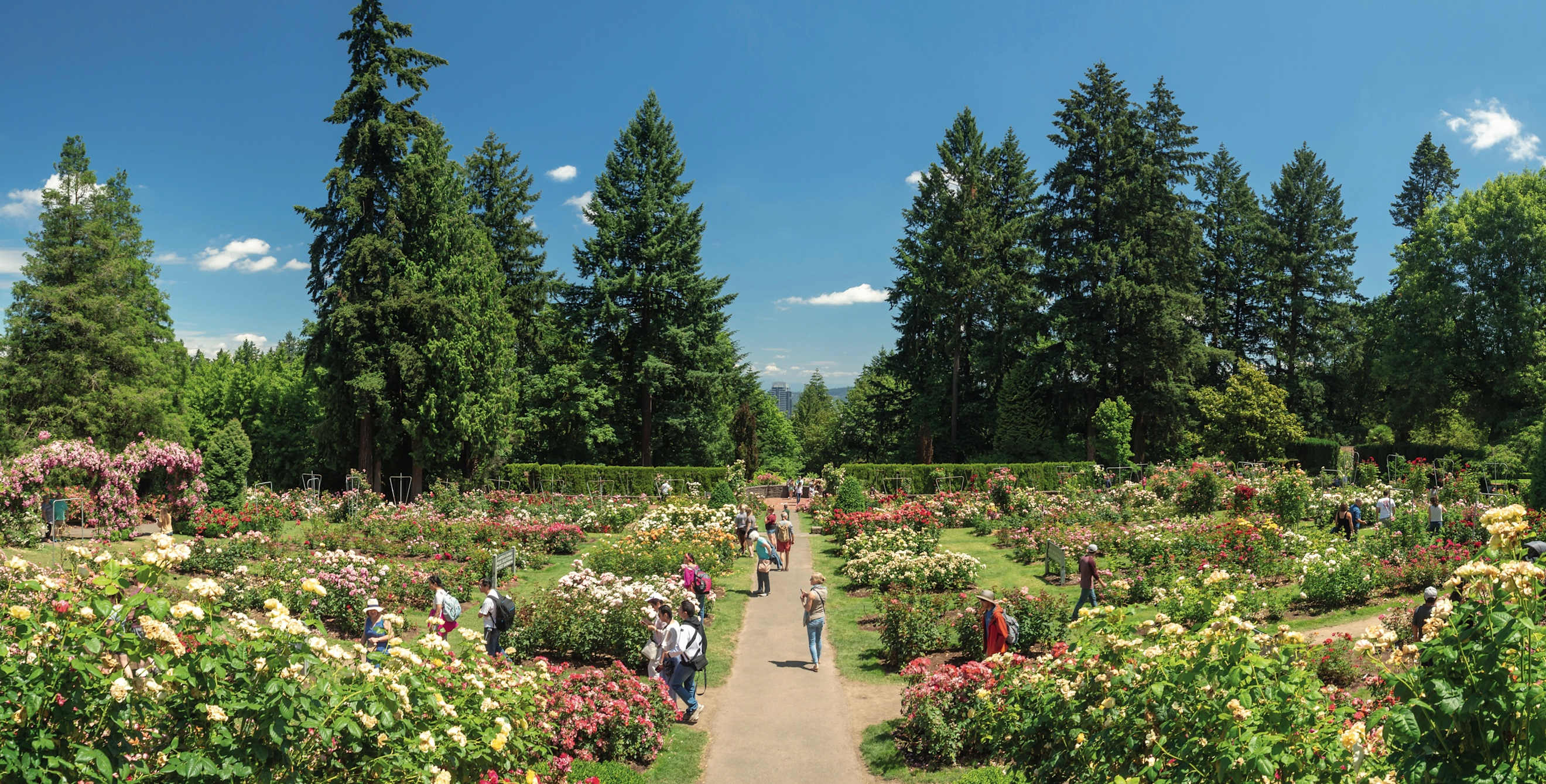
Downtown, amid the concrete and skyscrapers, Portland feels decidedly urban. But the truth is, it's also a green city: nestled in trees, softened by rain, fringed by volcanoes. And there's no better way to connect with all that nature, I'd argue, than by heading west of downtown, crossing 405, and wending your way up the hill through the Goose Hollow neighborhood into the cool, forested refuge of Washington Park.
The park is nature amplified. In Hoyt Arboretum are 2,000 species of trees, many exotic—the bright-green Chinese walking stick bamboo, for instance. The zoo has slender-snouted crocodiles paddling in its aviary pond, and the Washington Park light-rail station sits 260 feet underground, drilled into bedrock basalt carved by the Missoula Floods 13,000 to 15,000 years ago.
But even as Washington Park communes with the region's wild past, it is remarkably civilized. The 10,000 bushes in the park's premier attraction, the International Rose Test Garden, are pruned just so. And it's here, in the rose garden, that the Royal Rosarians, who travel the globe representing Portland, gather each June, in white gloves and cream-colored suits, to conduct their annual knighting ceremonies.
Washington Park was officially founded in 1871, but it sat largely untouched and forgotten for three decades. Then in 1903, while readying for the Lewis and Clark Exposition, Portland's municipal fathers laid the cornerstone for a Washington Park monument, a lofty granite column honoring the famed explorers. In 1905, a lion named Nero was introduced to the park's nascent zoo—only to escape, eight years later, for a 90-minute hillside romp that saw his keeper pelting him with what the Oregonian described as "harsh expletives."
Today, Washington Park encompasses 410 acres and includes an archery range, a secret garden, and a surfeit of intriguing statues and monuments. And still it keeps evolving. In 2015, Portland Japanese Garden—itself built on the site of an old zoo—kicked off an ambitious two-year expansion led by lauded architect Kengo Kuma. In late 2016, crews began a project to swap the park's antique concrete reservoir for a 12.4-million gallon underground tank, which, come 2024, will be topped by two glimmering reflecting pools.
But the fundamental draw of Washington Park will never change. The trees, the fresh air, the scent of rosebushes on a warm day in spring—these joys will always be there. And to drink them in, you just need to climb the hill. Come on, let's go.

The platform of the Max Station shares geological history with passers-by.
Washington Park Max Station
If you take the light-rail to the park, stop as you're leaving the terminal and you'll see something unusual. Next to the platform, two tubes display a core sample that construction crews drilled before boring down 260 feet to create this station. Beside the tubes, inscriptions deliver a condensed history. The time line begins with soil that sat on earth's surface 15.6 million years ago. Later, there's a layer of ancient lava. Further along, newer soil is paired with inscriptions detailing human inventions. The toothbrush (1498) and paper clip (1900) are jammed together at the very end of the time line.
Visual Highights
- The WPA did projects across Oregon, from the Burnside Tunnel to the Yaquina Bay Bridge. See their work on the stone staircase leading into the Washington Park Amphitheater
- Look closely at the blocks at the Park Place entrance, and you'll make out subtle art deco lions. They bring welcome life to this area, in contrast to the stoic Lewis and Clark column above.
- The path into the Secret Garden, paved with Belgian blocks, has an old-world feel. The rectangular stones were favored on 19th-century streets because they afforded a better grip for horses.
- Portland Japanese Garden's Sand and Stone Garden features meticulously raked, fine white gravel set against large moss-covered boulders—a study in sublime restraint.
- A three-ton boulder sits on a lawn near Rose Garden Way, hinting at what the granite-rich Northwest used to look like before its bedrock was buried in lava 2.5 million years ago.
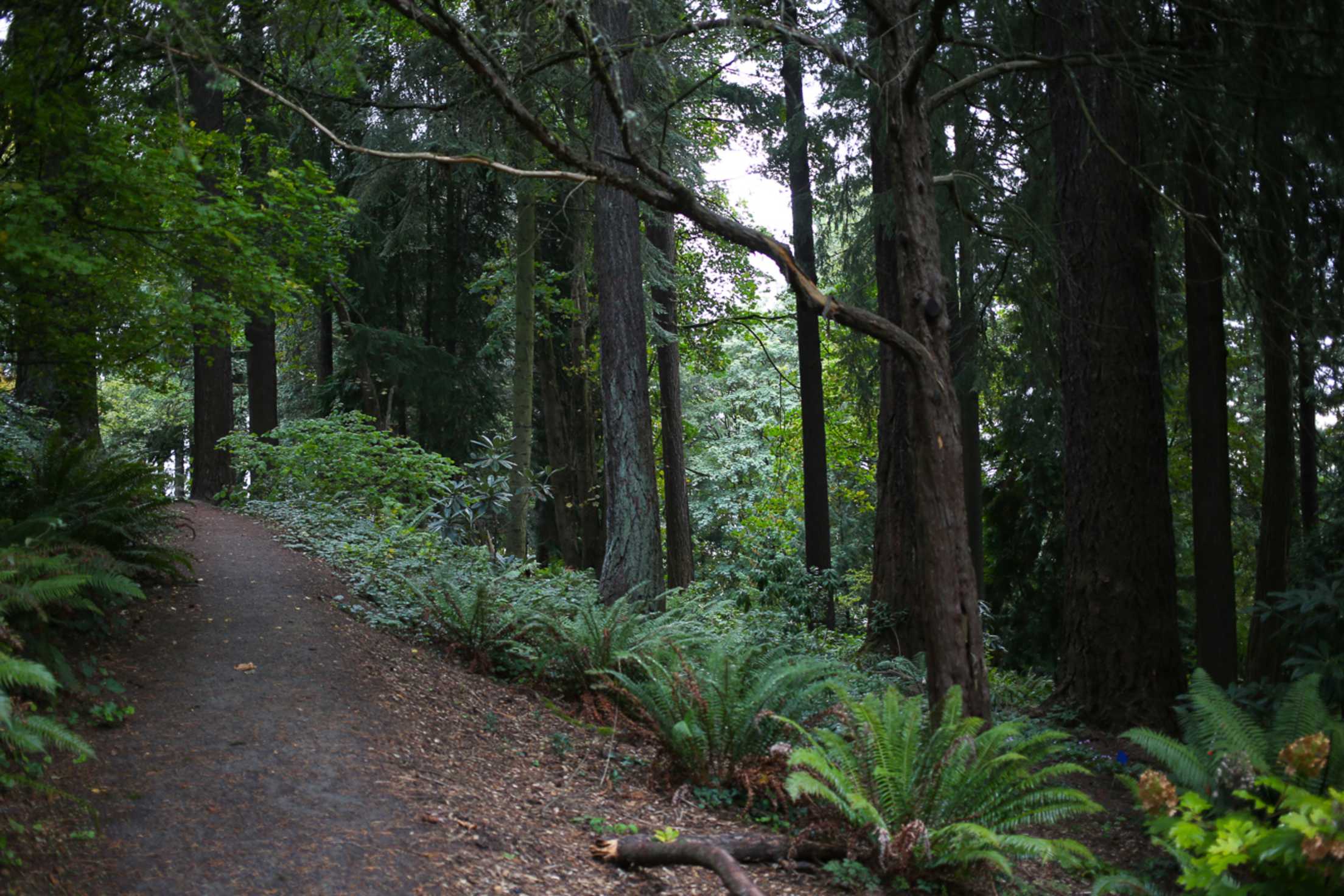
Discover a two-acre collection of 220 rhododendron species in the Himalayan Cloud Forest Garden.
Himalayan Cloud Forest Garden
Eight years ago, the flanks of Stearns Canyon were a tangle of English ivy strewn with trash. Now, thanks to the tireless efforts of a few horticulturists, those slopes are home to a two-acre collection of 220 rhododendron species, most hailing from Asia. The leaves of the Rhododendron sinogrande are so sturdy, they're used as dinner plates in China. The skin of Viburnum cylindricum is soft enough that, if you scratch it, you can inscribe words on the leaf. Just don't ask the garden's creator, Bill Zanze, to pick his favorite rhododendron. "Would it be OK," he asks, "if I narrowed it to 30 or 40?"
Perfect Picnic Sites
- The stone benches beside the Lewis and Clark Memorial column offer a great bird's-eye view of the city, its tall buildings backed by the blue Willamette. If the weather cooperates, you might be able to make out the Wells Fargo Center scraping the sky beside the KOIN Center
- Spread a picnic blanket on the grassy terraces of the Washington Park Amphitheater and scan the horizon for Mount Hood and Mount St. Helens. Or find quiet on the hedge-lined lawn of the Secret Garden; reach that hidden oasis from Rose Garden Way, or by descending a vine-covered stairway from the Arlington Heights neighborhood.
- Prefer a picnic table? You'll find several at the park's two covered shelters. One, the Elephant House, remains from an earlier incarnation of the Oregon Zoo; the other, a comely A-frame named Stevens Pavilion, sits in the middle of Hoyt Arboretum.
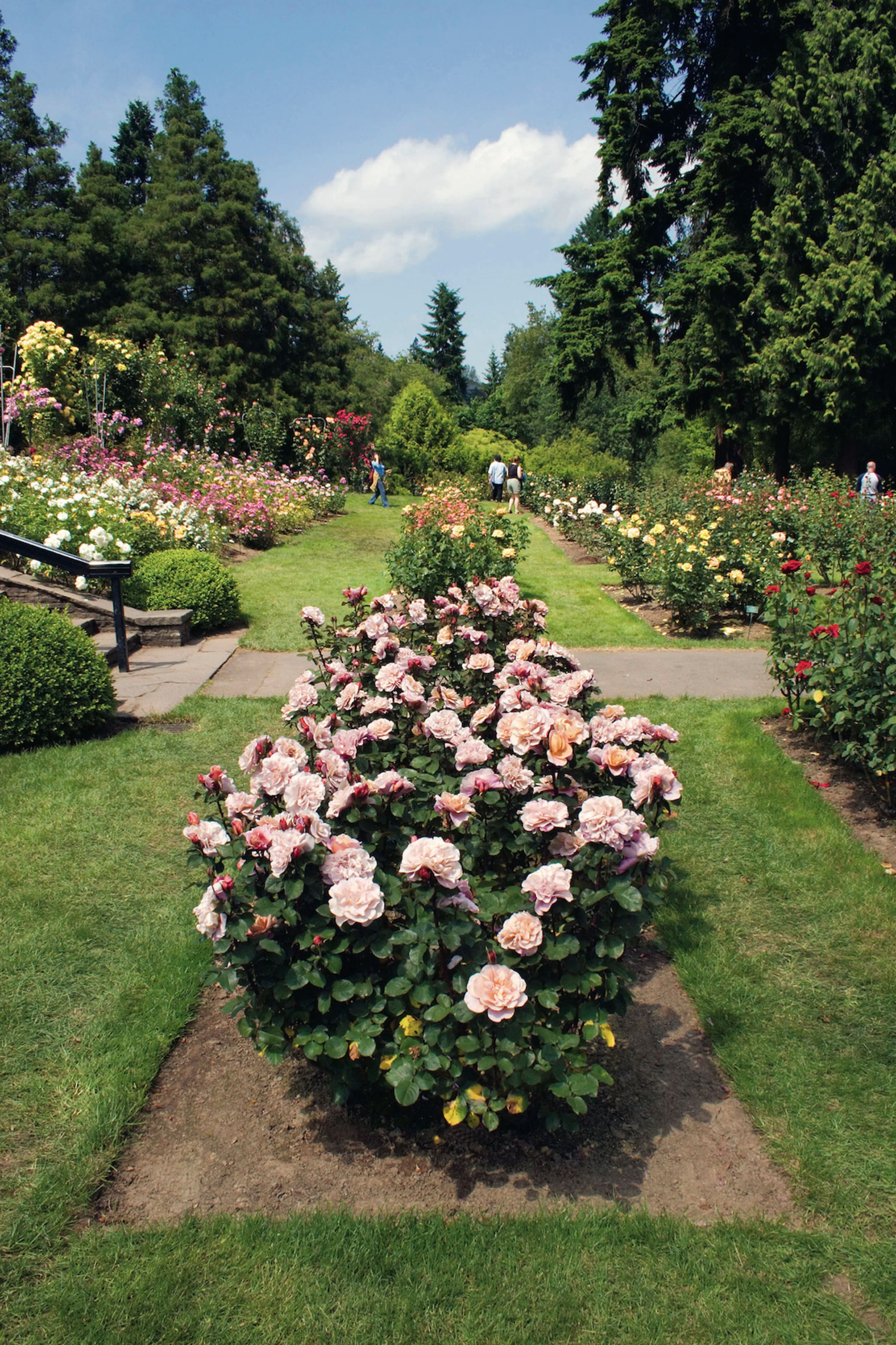
The International Rose Test Garden showcases a rainbow of colorful blooms.
International Rose Test Garden
Stand uphill from the International Rose Test Garden, and you can soak up the dizzying dance of red, lavender, white, yellow, magenta, and violet below. Or descend the steps into the terraced hillside nirvana for a private audience with more than 600 types of roses, including Portland's signature flower: the goblet-shaped, silvery-pink Madame Caroline Testout. This rose was planted along the streets by the thousands before the 1905 Lewis and Clark Exposition, and locals so loved the flower that Mayor Harry Lane was inspired to launch the Portland Rose Festival, an annual gala whose opening parade now draws half a million spectators.
Another cultivar, the crimson, poppylike Duchess of Portland, commemorates the Grand Duchess Charlotte of Luxembourg's 1943 visit to Washington Park to raise funds for the war against Hitler. The blooms peak between June and October, but the garden's lofty perspective— encompassing downtown Portland and, on clear days, the snowcapped mountains east of town—is breathtaking all year-round.
Excellent Eats
- Inside Portland Japanese Garden, the Umami Café offers Japanese tea service and boundless side plates, ranging from matcha mochi to chicken fried rice.
- You can dine at the zoo's Cascade Grill without paying admission. Menu options include burgers, salads, and excellent nitro beers, all at reasonable prices.
- On summer weekends, Olympia Provisions runs a deluxe hot dog cart near the rose garden. Try the Kasekrainer, a sausage studded with Emmentaler cheese.
- Buy picnic provisions at Zupan's Markets, a West Burnside grocery and deli packed with salads, salamis, prosciutti, poke bowls, and other goodies.
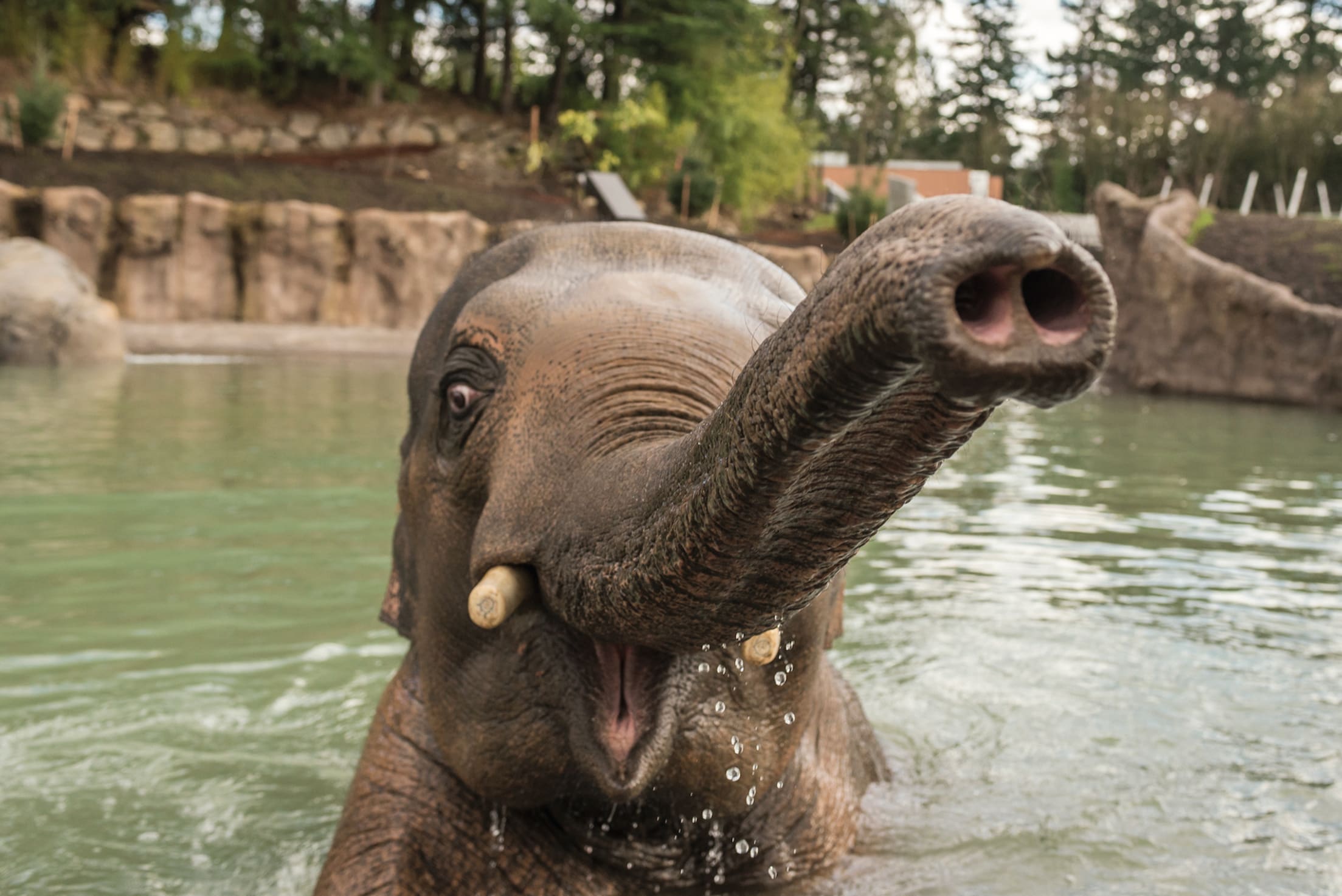
Animals frolic and play across 64 acres at the Oregon Zoo.
Oregon Zoo
The Oregon Zoo is home to some 230 species and about a million glimpses into the animal world. Want to see baby flamingos learning to walk? Check. Obstreperous armadillos kicking each other? Come on down! How about western pond turtle hatchlings "sunbathing" under heat lamps? As it happens, a whole fleet of them recently arrived.
The zoo, at 64 acres, seems like a small kingdom, with five habitat zones ringing a gracious lawn. It's nearly impossible to recommend a specific critter to visit. (Would you prefer the sharp-fanged Pacific lampreys, or the frolicsome Humboldt penguins cavorting in the Penguinarium?) But a certain crowd-pleaser is the small red panda. Four-year-old Mei Mei, who represents an endangered species native to Asia, spends much of her time napping and grooming herself like a cat. She bears little resemblance to her larger, more famous black-and-white brethren, but she's enchanting. "She's kind of like a raccoon," one young zoo visitor remarked recently, "only cuter."

Magnolias bloom at the Hoyt Arboretum.
Hoyt Arboretum
Ensconced in the park's endless tapestry of Douglas firs and big-leaf maples, this 190-acre collection of trees contains species ranging from common to rare and exotic. Playing the starring role are 13 dawn redwoods, which abounded in Oregon millions of years ago and then, many believed, went extinct. Modern specimens of this deciduous conifer were discovered in China in 1941, then planted here. Grab a map at the visitor center, then see the celebrity trees from the Spruce Trail.
Even when the dawn redwoods have shed their needles, there's always something to see here. The dogwoods and cherry trees blossom in spring, some magnolias bloom into August, and the Korean maples turn red in the fall. And if you hike just a third of a mile from the road on the Wildwood Trail, you can stand on the Redwood Deck and crane your neck to see the crowns of trees 150 feet above you, reaching for the sky.
Stellar Strolls
- The easy Hoyt Arboretum Loop travels through honey locusts, patches of thimbleberry, and a group of rhaetic pines whose trunks may be speckled with holes drilled by sapsuckers.
- At 30-plus miles, the Wildwood Trail, linking Washington and Forest Parks, is one of the longest urban hiking trails in the nation. It begins in Hoyt Arboretum, crosses West Burnside, then enters Pittock Acres Park. Here, you can tour newspaper magnate Henry Pittock's pleasure palace. (AAA members get $1 off admission.) When the path reaches Forest Park, you are all but in wilderness.
- Not up for the whole length of the Wildwood? Just mosey down to West Burnside and check out the brand-new Barbara Walker Crossing, which arcs over the busy road. Named for a late urban parks and trails advocate, the welded steel span—designed by architect Ed Carpenter—calls to mind sword ferns and vine maples.
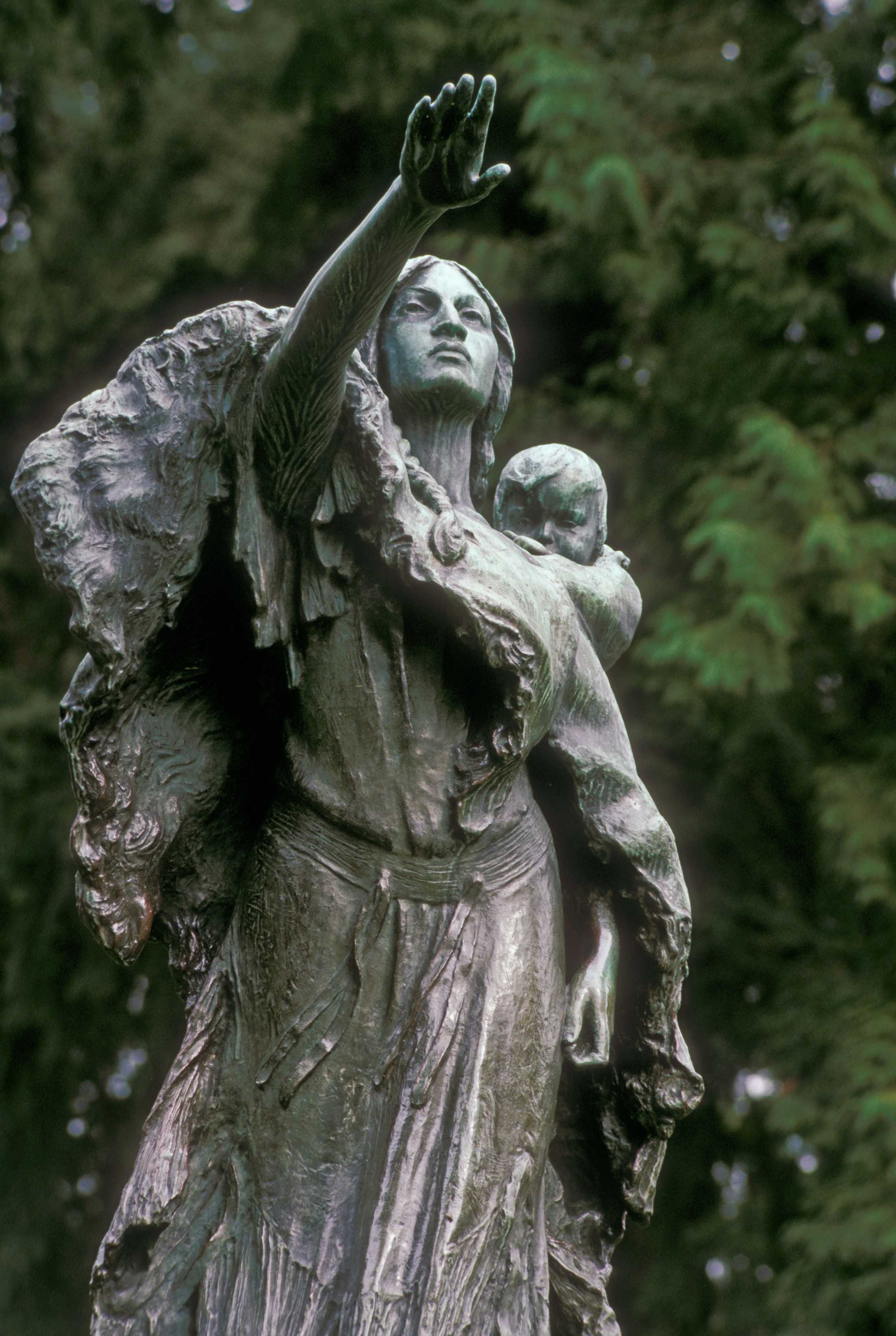
The seven-foot-tall bronze Sacagawea sculpture.
Sacagawea Sculpture
Not far from the Lewis and Clark monument, a seven-foot-tall bronze Sacagawea recalls a hopeful historical moment. In the early 1900s, as women rallied for the right to vote, admiration welled up for this young Shoshone woman who served as an interpreter for Lewis and Clark on their long journey to the Oregon Coast. The Portland Woman's Club sold Sacagawea-themed spoons and buttons and, joining with other women nationwide, raised $7,000. They then hired a Denver sculptor, Alice Cooper (not that one), to create this work, immortalizing a westward-pointing Sacagawea carrying her baby, Jean Baptiste.
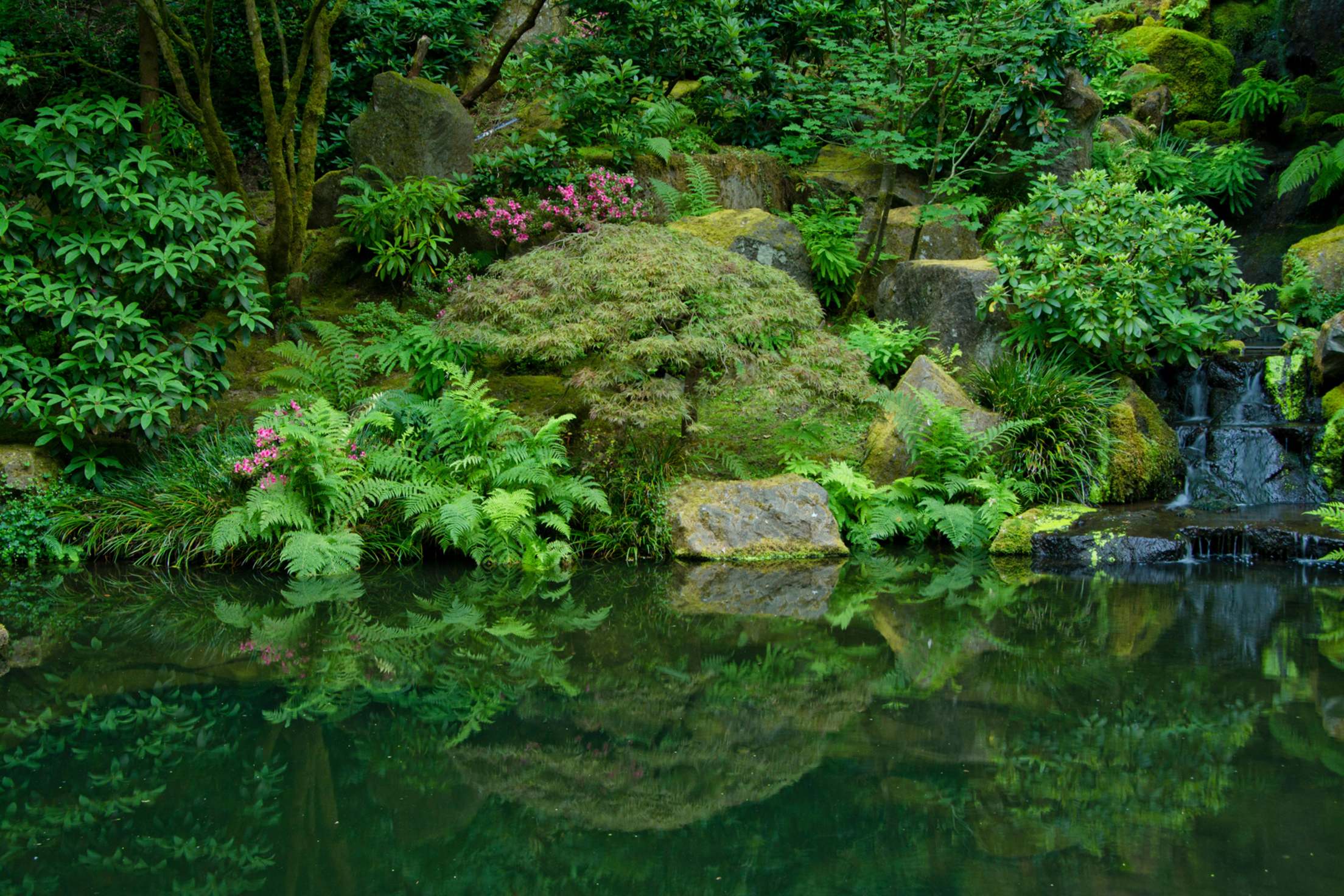
Find the verdant Strolling Pond Garden at Portland Japanese Garden.
Strolling Pond Garden
Superfans of The Simpsons surely know that Bart lives on the fictional Evergreen Terrace. That's because show creator Matt Groening grew up on the real Evergreen Terrace, near Washington Park. To see where he might have gotten the idea for a show about a young punk, head to the Strolling Pond Garden at Portland Japanese Garden. When Groening was a boy, this garden hadn't been built; these pools were part of a closed zoo. What is now the Lower Pond was then a bear wallow. "My friends and I would climb the fence of the old zoo," Groening said recently, "and swim in the bear pools. And they were... green."
Water Features
- A century ago, Portland's gentry would stop to water their horses at the Chiming Fountain. Today's visitors can find the three-tiered fountain near the Sacagawea statue. It makes an excellent wading pool, and its liquid music is lovely, even if it is more of a soothing splashing sound than a chime.
- At the base of Stearns Canyon, you'll see three functioning chrome-plated brass drinking fountains set into a curving granite wall: Loyal B. Stearns Memorial Fountain. This watery tribute was created by A.E. Doyle & Associates, the architecture firm responsible for the city's main library.
- Brawny, shimmering vertical and horizontal beams make up the Frank E. Beach Memorial Fountain. The abstract stainless steel sculpture brings a distinctly modern cool to the orderly rose garden.

The roofs of the buildings at the Portland Japanese Garden were inspired by geese in flight.
Portland Japanese Garden
Already exquisite, Portland Japanese Garden recently underwent a $37 million expansion, adding several handsome glass and wood buildings designed by Kengo Kuma, the architect who masterminded the main stadium for the 2020 Tokyo Olympics.
Topped by angular roofs inspired by geese in flight, the buildings frame a spacious stone courtyard, evoking the traditional Japanese gate-front villages, or monzen-machi, that surround shrines and temples. This hilltop redoubt, just outside the official garden entrance, houses rotating art exhibits, a small library of botany books, and the enchanting, cedar-walled Umami Café. At the back of the complex stands a striking 20-foot-high castle wall wrought from 800 tons of Oregon granite—without mortar—by 15th-generation stonemason Suminori Awata.
Inside the garden, past the lion-flanked walkway, eight separate spaces deliver different takes on tranquillity. In the Tea Garden, visitors walking down a lantern-lined path toward the teahouse may feel like they're venturing out to a rural village. The setup of the Flat Garden encourages guests to view the scene from a single position to better appreciate the artistry behind the flat stones juxtaposed against the neatly trimmed shrubbery. In the Natural Garden, waterfalls tumble down mossy hillsides over jumbles of rock. The sound of the trickling water itself is a balm to the nerves.
Time Capsule
On May 21, 1903, using a silver trowel with an ivory handle, Theodore Roosevelt buried a time capsule in the foundation of the Lewis and Clark Memorial column. The ceremony was so grand that no one remembered to chart the artifact's precise location. A century later, the Oregon Historical Society considered using gamma radiography and ground-penetration technology to find the capsule, but never initiated a formal hunt. Today, the society's director, Kerry Tymchuk, opposes such a search. "My inclination," he says, "is to live with the mystery, knowing that somewhere down there is a link to one of our greatest presidents."
Kid-friendly Spots
- At the indoor viewing area of the zoo's Steller Cove, otters and harbor seals swoop, bellies up, toward the giant glass windows as kids look on, oohing and aahing in amazement.
- The zoo railway winds past Elephant Lands and the family farm. The Jetsons-esque Zooliner is a scale replica of the Aerotrain, a once futuristic locomotive born in the 1950s.
- The playground at the Rose Garden Children's Park has swings, slides, and monkey bars. A statue in the sandbox honors Rosy, a former zoo resident who was the city's first elephant.
- Inside the World Forestry Center, a boat, a train, a Jeep, and an elevator await, ready to whisk visitors on simulated rides through distant lands. (AAA members get $1 off admission.)

Discover the Witch's Castle and other unexpected gems in Forest Park.
Stumptown Neighbor: Forest Park
Beginning just a mile from downtown and stretching west for eight miles, Forest Park is the nation's largest urban forest, at 5,200 acres, and also the city's refrigerator. You're in the gracious shade of evergreens here, and cool creeks run through the canyons. Save for a few rocks and tree roots, the ground is soft underfoot, and the sound of traffic is nothing but a far-off murmur.
Created in 1948 on slopes too steep for houses, Forest Park is enticing to mountain bikers who take to the curving, gently climbing 10.3-mile Leif Erikson Drive, and also to hikers who know that the 30.2-mile-long Wildwood Trail becomes progressively calmer and less peopled as it spills west, away from the city. All told, 80 miles of hiking trails and 28 miles of mountain bike trails crisscross the park. Beside the Lower Macleay Trail stands the Witch's Castle, its crumbling walls kissed by moss; nearby is an Audubon Society sanctuary where parkgoers might glimpse birds such as Xena the American kestrel and Aristophanes, a friendly raven.
Wildlife is everywhere in the park. Cutthroat trout swim in the treelined creases of Balch Creek, and elsewhere large herds of elk are occasionally sighted, as are bobcats and weasels. Last year, one jogger had a close encounter with a flying bat. "It was kind of a freaky experience," a stunned but intact Bill LaMarche later reported. "I got hit in the back of the head with what felt like a baseball."
Ah, wilderness.
If you're planning on traveling to Portland, talk to AAA Vacation Experts for free.